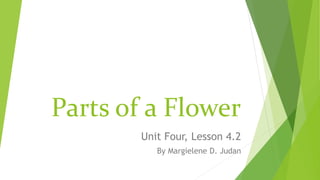
Unit 4, Lesson 4.2 - Parts of a Flower
- 1. Parts of a Flower Unit Four, Lesson 4.2 By Margielene D. Judan
- 2. Lesson Outline Introduction: Sexual Reproduction Flowering Plants Parts of a Flower
- 3. Reproduction Reproduction is the creation of “new individuals” from existing individuals.
- 4. Two Types of Reproduction Sexual – involves sex cells (egg, sperm) Asexual – does not involve sex cells
- 5. Refer to p.125 In asexual reproduction, the parent cell is SINGLE AND DIVIDING. (ex. amoeba, hydra, fungi, bacteria, etc.)
- 6. Refer to p.125 In sexual reproduction, the offspring are genetically identical (exact clones) to their parents. (ex. humans, elephants, dogs, fishes, plants, etc.)
- 8. Sexual Reproduction Involves union of gametes Gametes = sperm (male) + egg (female) Trivia: The egg is the largest cell in the human body while the sperm is the smallest.
- 9. Sexual Reproduction Sperm – mobile and small Egg – immobile and large During fertilization, they unite (n + n) to form a diploid (2n) zygote (fertilized egg)
- 10. Nonflowering Plants They are called gymnosperms (we will not discuss them).
- 11. Flowering Plants Comprises 90% of plant species Classified as either: 1. Angiosperms – have seeds enclosed in ovary 2. Anthophytes – plants that produce flowers. They have an ovary that’s part of the flower
- 12. Flowers Reproductive organs/structures of a plant Most flowers are hermaphrodites (contains both male and female sex organs)
- 13. Parts of a Flower Corolla Calyx Stamen (male) Pistil (female) Receptacle Peduncle (Be sure to be able to memorize and label each part)
- 15. Accessory Parts – function mainly for support, protection and attraction • Corolla • Calyx • Receptacle • Peduncle
- 16. Corolla Comprises of the petals Have various shapes, sizes, and colors Function: protection, attraction
- 17. Calyx Comprises of sepals (typically green) Leaf-like Function: Protect the flower when it was still young sepal
- 18. Receptacle Also called torus Function: Supports the entire flower (base of the flower) receptacle calyx
- 19. Peduncle Also called stalk Function: Connects the flower to the branch or stem. peduncle
- 20. Reproductive Parts – for reproduction; main parts of a flower 1. Stamen (male) 2. Pistil (female)
- 21. Stamen The male reproductive organ Collectively called androecium (collective noun) Composed of two parts: 1. Anther 2. Filament
- 22. Anther Expanded lobular structure at the end of the filament Function: Produces pollen (male sex cell)
- 23. Filament Function: Stalk that supports and holds the anther
- 24. Pistil or carpel The female reproductive organ Collectively called gynoecium (collective noun) Composed of three parts: 1. Stigma 2. Style 3. Ovary
- 25. Stigma Swollen tip of the pistil Function: Covered by sticky substance for pollen grains to adhere (stick) to stigma Pollen grains (purple dots)
- 26. Style Function: Long, slender tube that connects the stigma to the ovary Acts as a conveyor (carrier from one place to another) of pollen grains style
- 27. Ovary Enlarged basal portion of the pistil Function: Houses the ovule The ovule houses the egg cell
- 28. Ovary In cross section, internal parts of the ovary can be seen: Carpel Locule Ovule Funiculus Placenta
- 29. Ovary Carpel – segment or partition that comprises an ovary Ovary wall – supports the ovary Ovary with 3 carpels
- 30. Ovary Locule – space or cavity within the carpel An ovary with 3 carpels has also 3 locules room-like locules
- 31. ovules (2 ovules per locule) Cross-section of a plant ovary carpel
- 32. Ovary Ovary core – solid structure at the center Placenta – the edge of the core; nourishes the egg core (yellow); placenta (green) Visual representation core placenta placenta core
- 33. Ovary Finuculus – short stalk that connects the ovule and placenta finiculus finiculus
- 34. Ovary Ovule – produces the egg (2 ovules per lenticel) ovule ovule ovule
- 37. Cross-section of an ovule The ovule has the following parts: 1. Integument - 2 layer protective coat 2. Nucellus – mass of tissue consisting of meristematic (dividing) cells 3. Funiculus 4. Embryo sac – contains the egg
- 38. (ovary sac) (ovary sac)
- 39. Development of Gametophytes (Egg) Two Stages 1. Megasporogenesis (genesis = beginning/creation) – creation of megaspores 2. Megagametogenesis – creation of the gametes (egg)
- 40. Development of Gametophytes (Egg) 1. Megasporogenesis A. Ovule produces megaspore mother cell (2n). B. Megaspore mother cell (2n) produces 4 megaspores (n) via a two- time meiosis. C. 3 megaspores die and only one is left to continue. 2n n n meiosis n n meiosis n n meiosis
- 41. Development of Gametophytes (Egg) 1. Megagametogenesis A. The surviving megaspore divides via mitosis 3 times, forming 8 haploid (n) cells) n megaspore n n n n n n nnnnnnnn mitosis mitosis mitosis mitosismitosismitosismitosis 8 haploid (n) cells
- 42. Egg Development in Ovule B. Among the eight cells: 3 cells migrate near the micropyle. The one at the center becomes the egg while the other two becomes the synergid cells. The other 3 migrate on the opposite pole and become antipodal cells. The remaining 2 cells are naked (no membrane) and remains at the center to become the polar nuclei. micropyle egg synergidsynergid antipodal polar nuclei
- 44. Egg Development in Ovule C. These 8 cells form the inside of the embryo sac and are ready to be fertilized by a pollen (from the male).
- 46. Pollen Development in the Anther (Male) Like egg development, pollen development undergoes meiosis and mitosis to produce pollen grains. The product is 2 pollen grains. 1. Microsporogenesis – creation of microspore 2. Microgametosgenesis – creation of male gametes (pollen)
- 48. Assignment: p. 143 (Check Your Knowledge A: #s 1-10)
- 49. Sources: Science Links 7